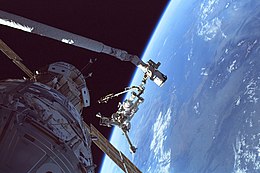
Back STS-96 Arabic STS-96 Bulgarian STS-96 Catalan STS-96 Czech STS-96 Danish STS-96 German STS-96 Greek STS-96 Spanish STS-96 ET استیاس-۹۶ FA
 Jernigan outside Unity, during the mission's only EVA | |
| Names | Space Transportation System-96 |
|---|---|
| Mission type | ISS assembly ISS logistics |
| Operator | NASA |
| COSPAR ID | 1999-030A |
| SATCAT no. | 25760 |
| Mission duration | 9 days, 19 hours, 13 minutes, 57 seconds |
| Distance travelled | 6,000,000 kilometres (3,700,000 mi) |
| Spacecraft properties | |
| Spacecraft | Space Shuttle Discovery |
| Launch mass | 118,857 kilograms (262,035 lb) |
| Landing mass | 100,230 kilograms (220,980 lb) |
| Payload mass | 9,097 kilograms (20,056 lb) |
| Crew | |
| Crew size | 7 |
| Members | |
| Start of mission | |
| Launch date | 27 May 1999, 10:49:42 UTC |
| Launch site | Kennedy, LC-39B |
| End of mission | |
| Landing date | 6 June 1999, 06:02:43 UTC |
| Landing site | Kennedy, SLF Runway 15 |
| Orbital parameters | |
| Reference system | Geocentric |
| Regime | Low Earth |
| Perigee altitude | 326 kilometres (203 mi) |
| Apogee altitude | 340 kilometres (210 mi) |
| Inclination | 51.6 degrees |
| Period | 91.2 min |
| Docking with ISS | |
| Docking port | PMA-2 (Unity forward) |
| Docking date | 29 May 1999, 04:23 UTC |
| Undocking date | 3 June 1999, 22:39 UTC |
| Time docked | 5 days, 18 hours, 15 minutes |

 Left to right - Front row: Rominger, Ochoa, Husband; Back row: Barry, Payette, Tokarev, Jernigan | |
STS-96 was a Space Shuttle mission to the International Space Station (ISS) flown by Space Shuttle Discovery, and the first shuttle flight to dock[a] at the International Space Station. It was Discovery's 26th flight.[1][2] The shuttle carried the Spacehab module in the payload, filled with cargo for station outfitting. STS-96 launched from Kennedy Space Center, Florida, on 27 May 1999 at 06:49:42 AM EDT and returned to Kennedy on 6 June 1999, 2:02:43 AM EDT.[1]
- ^ a b Warnock, Lynda. "STS-96". www.nasa.gov. NASA. Retrieved 15 June 2020.
- ^ "The International Lab in Space Helps Prepare for Life Beyond". American Association for the Advancement of Science. Retrieved 15 June 2020.